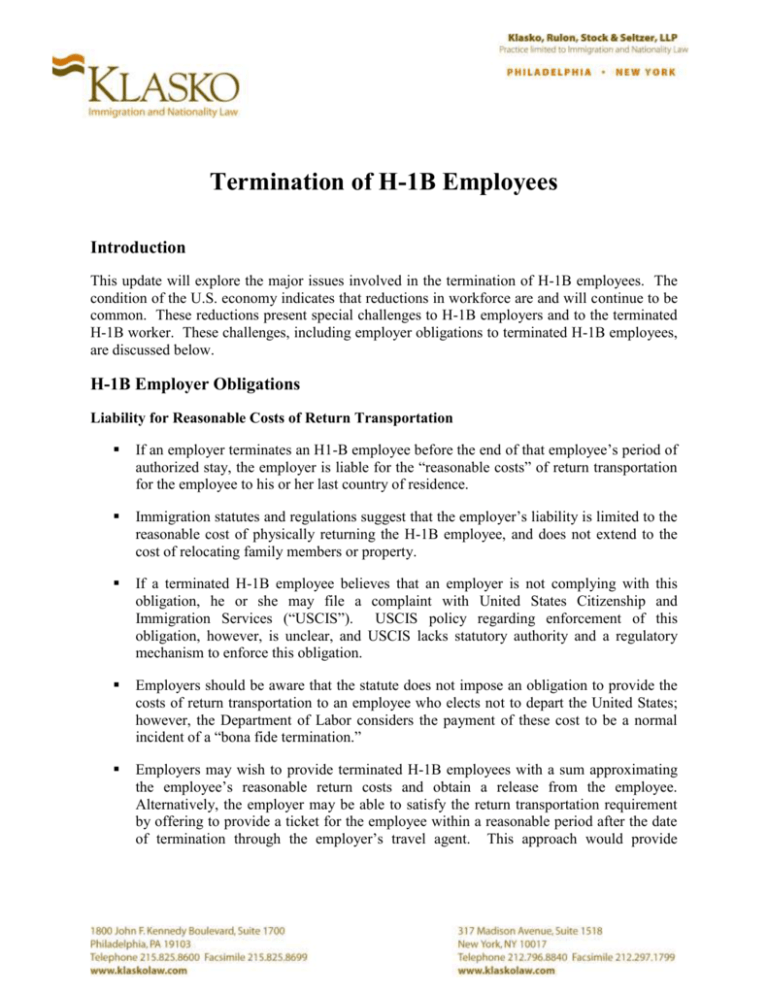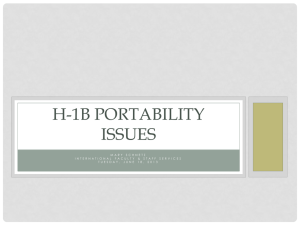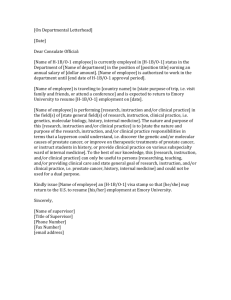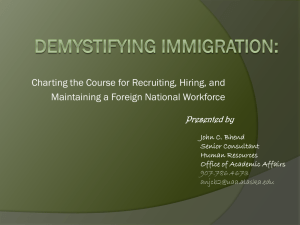Termination of H-1B Employees - Klasko Immigration Law Partners
advertisement

Termination of H-1B Employees Introduction This update will explore the major issues involved in the termination of H-1B employees. The condition of the U.S. economy indicates that reductions in workforce are and will continue to be common. These reductions present special challenges to H-1B employers and to the terminated H-1B worker. These challenges, including employer obligations to terminated H-1B employees, are discussed below. H-1B Employer Obligations Liability for Reasonable Costs of Return Transportation If an employer terminates an H1-B employee before the end of that employee’s period of authorized stay, the employer is liable for the “reasonable costs” of return transportation for the employee to his or her last country of residence. Immigration statutes and regulations suggest that the employer’s liability is limited to the reasonable cost of physically returning the H-1B employee, and does not extend to the cost of relocating family members or property. If a terminated H-1B employee believes that an employer is not complying with this obligation, he or she may file a complaint with United States Citizenship and Immigration Services (“USCIS”). USCIS policy regarding enforcement of this obligation, however, is unclear, and USCIS lacks statutory authority and a regulatory mechanism to enforce this obligation. Employers should be aware that the statute does not impose an obligation to provide the costs of return transportation to an employee who elects not to depart the United States; however, the Department of Labor considers the payment of these cost to be a normal incident of a “bona fide termination.” Employers may wish to provide terminated H-1B employees with a sum approximating the employee’s reasonable return costs and obtain a release from the employee. Alternatively, the employer may be able to satisfy the return transportation requirement by offering to provide a ticket for the employee within a reasonable period after the date of termination through the employer’s travel agent. This approach would provide Termination of H-1B Employees evidence that the employer made a good-faith effort to satisfy its obligation, while avoiding a windfall to an employee who elects to remain in the United States. A terminated employee may seek to enforce the employer’s obligation in state court; however, it is unclear whether such a suit could succeed. Employers should retain records of compliance with this obligation. USCIS Notification of Termination Regulations require an H-1B employer to notify USCIS “immediately” of “any material changes in the terms and conditions of employment” affecting an H-1B employee. USCIS policy is that a termination is such a “material change.” Employers may satisfy this notification obligation by sending a letter explaining the change or termination to USCIS office that approved the petition. Employers should be aware that there is no sanction provided in the USCIS regulations for failing to make timely notification of an H-1B worker’s termination (but see the discussion of DOL implications below). After receipt of a letter from an H-1B employer indicating that the H-1B employee is no longer employed by the employer, USCIS will respond with a notice revoking that employee’s H-1B petition. The eventual revocation of the H-1B petition may cause a dilemma for an H-1B employee, who may have remained in the United States to seek other employment, as discussed below. Employers should consider informing terminated employees of the employer’s obligation to notify USCIS of the termination and of the eventual revocation of the employee’s H1B petition that will result. Employers should retain records of compliance with this obligation. Department of Labor Implications Employers should be aware that the Department of Labor (DOL) has issued regulations preventing the “benching” of H-1B workers—that is, underpaying or not paying an employee who is not engaged on a matter that will produce revenue for the employer. These regulations impose a requirement that employees in nonproductive status or otherwise temporarily laid off “due to the decision of the employer” continue to receive their normal wages. This requirement ceases once there is a “bona fide” termination of employment. DOL regulations tie the obligation to pay an employee until “bona fide” termination to the obligation to inform USCIS of an H-1B employee’s termination. The DOL’s enforcement position has been that any evidence of a “bona fide” termination, such as written notice to the employee, will be sufficient to end the employer’s wage obligation. Klasko, Rulon, Stock & Seltzer, LLP Page 2 of 4 Termination of H-1B Employees A recent decision of the DOL’s Administrative Review Board, however, held that an employer’s obligation to pay the offered salary continues up until the date the employer sends notice of termination to USCIS. While USCIS’s position is that an H-1B petition is valid until revoked, so that a terminated H-1B employee whose petition has not been revoked could later begin work for the same employer immediately and would not need a new H-1B petition, the Department of Labor’s position is that failing to file a new petition means no “bona fide” termination occurred, so that the employer is liable for wages during the entire period between the “termination” and “re-hire.” Employers should maintain careful records of an H-1B employee’s termination, and immediately notify USCIS of the termination, in the event that the Department of Labor questions when the employee actually was terminated. Consequences for the H-1B Employee Maintenance of Status Contrary to popular belief, there is no “10-day,” “30-day” or other grace period for terminated employees holding H-1B status. Once the employment relationship terminates, the H-1B employee is out of status. While USCIS has proposed a 60-day period within which an H-1B worker may seek new employment, that period remains only a proposal. USCIS policy is that periods during which an H-1B employee receives severance payments, or remains on the employer’s payroll without reporting for work, are not periods of valid status for an H-1B nonimmigrant. Technically, H-1B employees who remain in the United States after termination of their H-1B employment without changing their status are in violation of their status, and persons in violation of their status are not allowed to change, amend or extend their status. In deciding whether to approve a change, amendment or extension of status for any out-of-status nonimmigrant, however, USCIS may exercise discretion on a case-bycase basis to grant the extension, change or amendment of status in spite of the failure to maintain status. The longer the time out of status, the less likely USCIS will be to approve the change, extension or amendment of status. If the period out of status is very short (10 days or less), a change, extension or amendment of status will usually be approved. USCIS offices, however, have increasingly refused to exercise discretion in favor of laid-off H-1B workers, unless the gap in status is very short. Terminated H-1B employees should be aware that time is not on their side. If the employee has plans to have another H-1B petition filed on his or her behalf, or to change to another nonimmigrant status, those plans should be implemented as quickly as possible. Klasko, Rulon, Stock & Seltzer, LLP Page 3 of 4 Termination of H-1B Employees Difficulty in Taking Advantage of the Portability Rules The portability rules allow an individual in H-1B status to begin work for a new H-1B employer as soon as the new employer files with USCIS a non-frivolous petition to extend and amend the H-1B employee’s status to reflect the new employer, if certain conditions are met. One condition is that the new petition must be filed before the “date of expiration of the period of stay.” USCIS has not made clear when the expiration of the period of stay occurs, though the same language has been interpreted in other contexts to refer only to the expiration date of the nonimmigrant’s Form I-94, rather than to when the nonimmigrant fails to maintain status. The dilemma for the terminated H-1B employee is that, if the period of stay expires on the last day of employment, the employee is left with little or no time to coordinate the filing of a new petition by a new employer. While the legacy INS indicated it would propose a grace period to allow terminated H-1B workers to take advantage of the portability rules for a particular period of time (such as 60 days), there has been little activity from the Department of Homeland Security on the issue so far. Conclusion There are many issues to consider regarding the termination of H-1B employees. This Update is a general treatment of these issues and challenges. Each individual termination will present unique circumstances that may require more detailed analysis. As individual terminations are carried out, both employers and employees should keep these general issues and challenges in mind and should consult with immigration counsel for an individual determination of their options. Klasko, Rulon, Stock & Seltzer, LLP Page 4 of 4



